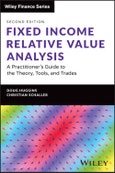Since its first edition in 2013, Fixed Income Relative Value Analysis: A Practitioner’s Guide to the Theory, Tools, and Trades has become the gold standard for guides linking financial theories with practical analysis tools. The newly revised second edition reflects both the progress in statistical tools over the last decade and the impact of the transition to SOFR on swap spreads.
You’ll find a set of statistical and financial tools, a multitude of actual trades resulting from the application of these tools, as well as access to a companion website featuring spreadsheets illustrating some of the models contained in the book.
This book covers: - Statistical models for quantitative market analysis, in particular mean reversion models and principal component analysis, now including the multivariate Ornstein-Uhlenbeck model. - An in-depth approach to understanding swap spreads in theory and practice. - A comprehensive discussion of the various basis swaps and their combinations. - The incorporation of credit default swaps in yield curve analysis. - A classification of option trades into three types and the appropriate analysis tools. - Fitted curve techniques for identifying relative value among different bonds. - A multi-factor delivery option model for bond future contracts.
Fixed Income Relative Value Analysis has proven to be an indispensable desk reference for buy- and sell-side fixed income professionals, including traders, quantitative analysts, portfolio managers, financial engineers, fixed income salespeople with sophisticated clientele and risk managers.
Table of Contents
Preface to the Second Edition vii
Chapter 1 Relative Value 1
Part I Statistical Models
Chapter 2 Mean Reversion 17
Chapter 3 Principal Component Analysis 51
Chapter 4 Multivariate Mean Reversion 111
Part II Financial Models
Chapter 5 Some Comments on Yield, Duration, and Convexity 137
Chapter 6 Some Comments on Yield Curve Models 143
Chapter 7 Bond Futures Contracts 149
Chapter 8 Fitted Bond Curves 167
Chapter 9 An Analytic Process for Government Bond Markets 183
Chapter 10 Overview of the Following Chapters: Asset, Basis, Credit Default Swaps and their Mutual Influences 187
Chapter 11 Reference Rates 193
Chapter 12 Asset Swaps 213
Chapter 13 Credit Default Swaps 233
Chapter 14 Intra-Currency Basis Swaps 265
Chapter 15 Cross-Currency Basis Swaps 271
Chapter 16 Combinations and Mutual Influences of Asset, Basis, and Credit Default Swaps 287
Chapter 17 Global Bond RV Via Fitted Curves and Via SOFR Asset Swap Spreads 307
Chapter 18 Other Factors Affecting Swap Spreads 321
Chapter 19 Options 335
Chapter 20 Relative Value in a Broader Perspective 385
Bibliography 393
Index 395








